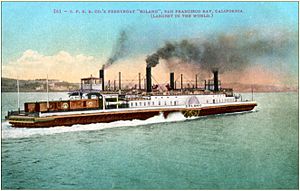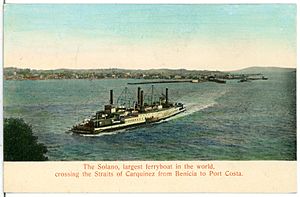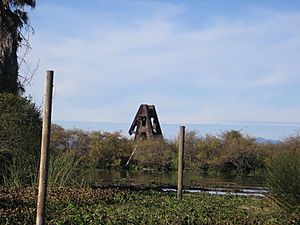Solano (ferry) facts for kids
The Solano was a giant railroad ferry that carried entire trains! It sailed across the Carquinez Strait in California for 51 years, from 1879 to 1930. When it was built, the Solano was the biggest train ferry in the world! It held this record for 35 years. Later, its sister ship, the Contra Costa, was built and was even longer.

Postcard of ferryboat Solano loaded with freight cars crossing the Carquinez Strait in California, ca.1910
|
|
| History | |
|---|---|
| Namesake | Solano County, California |
| Owner | Central Pacific Railroad |
| Route | Benicia, California to Port Costa, California and return |
| Cost | $350,000 |
| Maiden voyage | 24 November 1879 |
| In service | 1 December 1879 |
| Out of service | 15 October 1930 |
| Fate | Scuttled for breakwater c.1931 |
| General characteristics | |
| Type | Railroad ferry to transport entire trains |
| Length | 425 ft (130 m) |
| Beam | 116 ft (35 m) |
| Installed power | two 2,000 horsepower steam engines |
| Propulsion | two independent sidewheels |
| Speed | 12 mph |
| Capacity | 24-car passenger train with locomotive or 48-car freight train with locomotive |
Contents
Building a Giant Ferry
The Solano was designed by Arthur Brown. He was the superintendent of bridges and buildings for the Central Pacific Railroad. He made the ferryboat very strong, like a railroad bridge. It had four long wooden supports under its deck.
The ferry was powered by two large walking beam steam engines. Each engine had 2,000 horsepower. They turned huge paddle wheels on the sides of the ship. These paddle wheels pushed the Solano through the water.
Having two separate paddle wheels made the Solano very easy to steer. This was important because the Carquinez Strait had strong currents. The ferry also had two pilot rooms, one at each end. This meant it didn't need to turn around for return trips.
Ferry Slips and Size
Arthur Brown also designed the special docks, called ferry slips. The slip at Benicia pointed diagonally downstream. The slip at Port Costa pointed directly upstream. The distance across the strait was about one mile.
Each dock had a 100-foot long ramp, called a linkspan. These ramps had four sets of rails, just like the ferry. This made it easy to load and unload trains. The ramps could move up and down with the nine-foot tides.
The Solano was named after Solano County, California. It was built in 1879 in Oakland, California. The ferry was 425 feet (130 m) long and 116 feet (35 m) wide. It could carry a whole 24-car passenger train with its locomotive. Or it could carry a 48-car freight train with its locomotive.
First Journey
The Solano had its first test trip on November 24, 1879. About 75 special guests were on board, including Arthur Brown. They sailed around Alcatraz and arrived in Benicia. There was a big celebration with a military band and a salute.
The ferry could travel at about 12 miles per hour. On its first test, it went about 8 miles per hour. The Central Pacific Railroad built and operated the Solano. It helped connect the transcontinental railroad to the San Francisco Bay Area.
Before the Solano, the transcontinental railroad route was longer. The Solano helped make the route shorter and flatter. For many years, the Solano was the largest ferryboat ever built.
How the Solano Worked
The Solano started regular service in December 1879. It sailed between Benicia and Port Costa. Here's how a typical operation worked:
- A passenger train would arrive at the dock.
- The train would be uncoupled in the middle.
- A special engine would push the back half of the train onto one track on the ferry.
- The main engine would pull the front half onto another track.
- Then, the ferry would set off with the entire train and both engines on board!
The whole process, including loading, crossing, and unloading, took about 25 minutes. Two teams of 16 men worked to make this happen.
Years of Service
The Solano was in service 24 hours a day for 51 years. It sailed from December 1, 1879, to October 15, 1930. It only stopped for a few times for repairs and upgrades.
By 1904, the Solano was making 36 to 46 crossings every 24 hours. It carried about 115,000 freight cars and 56,000 passenger cars each year.
In 1914, its sister ship, the Contra Costa, was built. The Contra Costa was 13 feet longer than the Solano. This made the Contra Costa the new largest rail ferryboat. It was named for Contra Costa County, California.
The End of an Era
By 1927, both ferries were very busy. So, in 1928, the Southern Pacific Transportation Company decided to build a railroad bridge. This bridge would cross from Benicia to Martinez.
The railroad bridge opened on October 15, 1930. After the bridge opened, the Solano and Contra Costa were no longer needed. They were taken apart and sold for scrap.
Today, you can still see parts of the Solano. The "A frame" of its walking beam engine can be found in the San Joaquin River. It was sunk there to create a breakwater, which helps protect the shore from waves. The railroad bridge is still used today by the Union Pacific Railroad and Amtrak.





